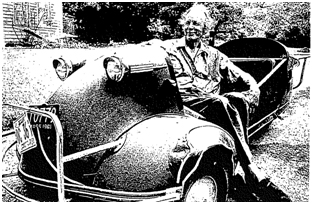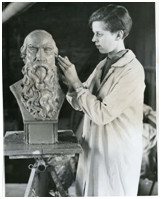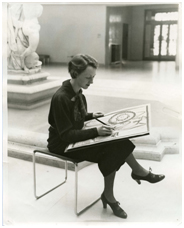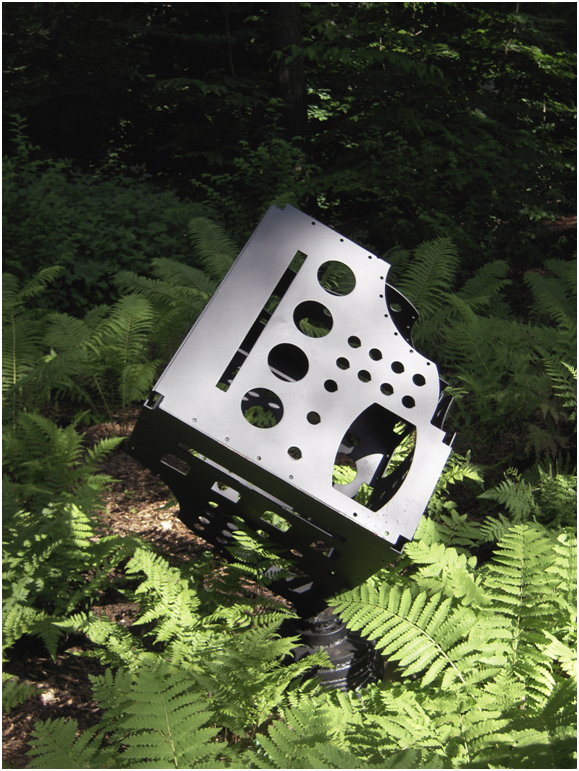
Home Structural Products & Services, Stairlifts
Structural Products & Services, Stairlifts
Furniture, Clocks,
Accessories
Antiques, Folk Art,
Fine Art, Auction Houses
FRED AND REBECCA JONES, (ALMOST) FORGOTTEN PIONEERS
by Gary Knoble
| Fred Jones, as he preferred to be called, was a sculptor, painter, architecture preservationist, restorer of yachts, and car collector. His wife, Rebecca Field, was a noted sculptor, water colorist, teacher, and a founder of the West Hartford Art League. Together they created “Jonesville” on Norton Lane in the center of Farmington. The Hartford Courant, in November 1969 said of Jones, “He’s an agnostic, scavenger, mechanic, carpenter, plumber, free-thinker and rugged individualist……..If ever there was an unordinary person it’s Frederic Jones.” |
|
|
Frederic Edward Jones was born on December 4, 1898 in Knighton-Radnorshire, Wales. His father Walter is said to have been a cattle dealer as well as the owner of the Norton Arms hotel. Jones had seven brothers and three sisters. (All of them were alive and living in the United States in 1969.) During World War I, he served in the British Army in a special unit that taught Russian to tank drivers. T. E. Lawrence, better known as Lawrence of Arabia, was a member of the same unit. In 1920 Jones emigrated with his mother and four sisters. They settled in Hartford, Connecticut on Niles Street. He quickly established a business specializing in the restoration of old houses in the Woodland Street area of Asylum Hill in Hartford. |
|
|
His wife, Rebecca Field Jones was born on March 13, 1905 in Montague, Massachusetts. Her father was Fred Field. She attended the Turner Falls High School, the Massachusetts Agricultural College, (now the University of Massachusetts), and the Massachusetts Art School in Boston. In the late 20’s she spent two years studying are in Munich, Germany. Upon her return to the United States she settled in Hartford. In 1933-35 she cofounded the West Hartford Art League where she taught for 40 years. Frederic and Rebecca met at the West Hartford Art League when he enrolled to study painting and sculpture. On March 20, 1941, they were married at the “Little Church Around the Corner” in New York City. Their wedding was announced in the Society Section of the Hartford Courant. The announcement noted that they were both well know sculptors who were both exhibiting works in at the 20th annual exhibition of the Connecticut Academy of Fine Arts at the Morgan Memorial in the Wadsworth Atheneum of Hartford. She was also noted for her watercolors. She was a WPA painter, with 39 works listed in the WPA inventory. In the 1940’s she was a committee member of the Hartford Society of Women Painters. He was a member of the Hartford Yacht Club. The couple settled in Farmington where they began the creation of what would be known as “Jonesville” on a small street they named Norton Lane, after the name of his father’s hotel in Wales. Rebecca taught at the Oxford School in West Hartford and also began teaching at Miss Porter’s School in Farmington, where she taught until she retired in 1968. During the 1940’s they created a group of six small historic structures, some of which were moved from nearby towns where they were slated to be demolished, and others they built out of materials they scavenged from old structures that were demolished. One of the structures was used by Fred for the restoration of old automobiles. He became a member of the Rolls Royce Club of America. He also favored three wheeled vehicles and called himself , “one of the oldest three-wheel men alive”. He later began to create a sculpture garden out of the junk iron he had collected. In 1973 he told a Courant writer that he began to create the sculptures in 1941 in order to clear his property of the iron that was scattered about. He went on to say: “I make my animals just the way they come into my mind and I do them for fun.” “It’s hell to be creative. You get to be a slave. It’s pleasant slavery, though.” “the world is full of people who make things from the world’s resources, but reclylement is fascinating. My life has always been recylement”. He says he is not a professional sculptor. “ “Sculptures are funny stuff to buy. You don’t just go and buy it to buy it, you’ve got to have the right place and everything.” (Continued next issue) |





